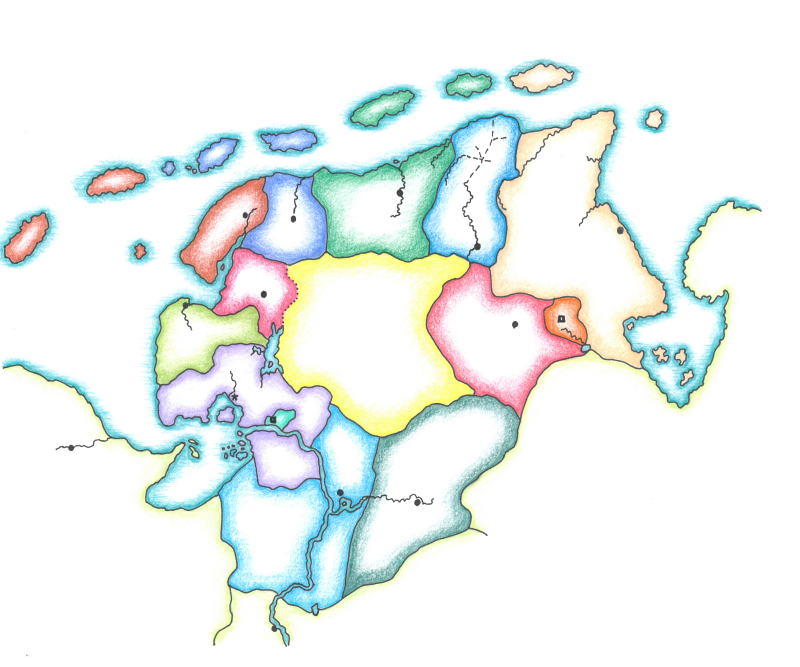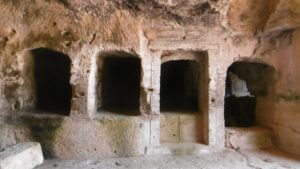Reading Map
This is the fourth article of a short series outlining a B/X D&D campaign.
- Atlantis of the Clay
- Warlock of the Pale Moor
- A Forsaken Peninsula
- Thirteen Graves
- Monstrous Denizens of the Pale Moor
- Beyond the Pale
- The Hex Lands
D. LOCATE AREAS UNDER HUMAN CONTROL.
Oft repeated on Emmius’s Tabula is “Amt” in conjunction with names of marked political regions. An amt is an administrative area akin to a province or county. Such small regions ruled by counts or nobles of similar rank seem appropriate.
Emmius shows ten provinces bordering the central region. Including the two small, more remote provinces—one on the river east of the Dollart, another on the opposite side of the map (left of the eastern inlet)—brings the count to 12. Twelve is a good number. Too good for a campaign with warlocks and witches, when we’re so close to 13. I’m going to carve one more county off the central region’s west end. It’s a “soft” border: the county claims, though does not control, the central region, which is the Pale Moor.
Competition
Going further with that notion, we already know that the warlock discovered much wealth and magic in the Pale Moor. So, the counties compete in some way for the forsaken interior’s resources, but they are confounded by the moor’s denizens. To increase the tension, we’ll add a curse: any who die within the confines of the Pale Moor return as undead, which also hinders incursion into the interior.
Opposition
Now, we have counties that desire something. Let’s also give them something to fear: an outside force. From the Valormr Campaign, we know that the dwarven empire of Throrgrmir lies to the east, and to the west, Darkmeer, a collection of belligerent fiefs. While Throrgrmir is a potential ally, Darkmeer is a certain enemy to civilized realms. Some time—decades or centuries—has passed since the Throrgrmir war. Darkmeer has recovered its losses and now threatens the counties with invasion, subjugation, and enslavement.
Character
Our thirteen counties should each have its own character to differentiate one from another. Space prohibits going into great detail, but we can sketch an overview of the political landscape and let the DM fill in the blanks. A handy way to divide the counties is by alignment.
Law: The counties united in an alliance against Darkmeer, a common threat. The alliance formed a duchy and elevated the ruler of the strongest county, whose seat is our base town (Emden on the Tabula), to the office of duke. The duke’s domain is shown in purple on the map, the other lawful counties in blues.

Chaos: Among the counties were some abstentions from the alliance. Notably, the county that claims the Pale Moor did not join and considers itself an independent state, as does the large county on the moor’s eastern border. These counties, and others shown in reds, are chaotic.
Neutrality: A few counties that joined the alliance are less keen on subjugation to a higher ruler. Some may pay homage to the duke, but when it comes to either defending the larger realm against chaos or making fruitful gains in the Pale Moor, their fealty is uncertain. Neutral counties are shown in greens and oranges.
Atlantis of the Clay
We don’t ignore the mythical source of our inspiration (see “Atlantis of the Clay”). An order of knights once held land on the west bank of the western inlet, where now is a bay. The order charged itself with the protection of the counties against the threat of chaos. Some decades ago, the land was submerged by a sudden deluge, possibly an act of divine retribution for some transgression. Villages were covered in mud. Castles were flooded, their lower floors inundated with silt. Many knights were lost. Survivors reaffirmed the order and its mission, and the strongest county gave to the order a tract of land on the river, where the knights established a palatinate.
Titles
Taking title names from English’s Germanic roots, I exchange duke for herzog, or feminine herzogin, and count for landgrave or landgravine. A vassal to a landgrave is a graf or grafin. A more martial province is ruled by a margrave. The head of the knightly order and ruler of the palatinate is a pfalzgraf. Then, for the ambiance in it, I want to play with words a little and, instead of counties, the political districts are graves.
Secret
Secret #4: Members of the ruling family of the chaotic grave that claims the Pale Moor are witches and warlocks, who consort with demons. Maybe they are possessed, maybe willing. Their goal is not to annex the Pale Moor but to reopen the gate beneath the ancient demon city.
Added a secret. [07:16 9 August 2022 GMT]

Pingback: Subscribe, Comment, and Coming Up – DONJON LANDS
Pingback: Monstrous Denizens of the Pale Moor – DONJON LANDS
Pingback: Base Town Emden – DONJON LANDS
Pingback: Encounters in the Hex Lands – DONJON LANDS
Pingback: Hekselannen – DONJON LANDS
Pingback: Beyond the Pale – DONJON LANDS